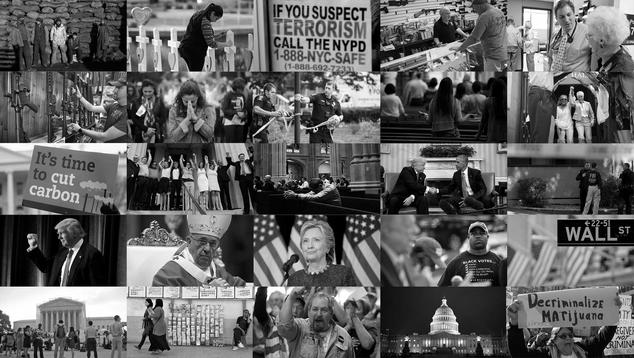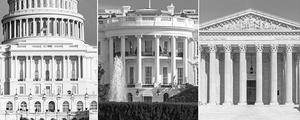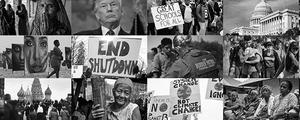WASHINGTON, D.C. -- A review of Gallup analyses over the past decade reveals that the years from 2010 to 2019 bore witness to key revolutionary changes in public opinion, along with some persistent trends and concerns, as well as striking moments and lasting effects.
Here are the changes, issues and moments in public opinion that Gallup editors think will long be associated with the 2010s:
Revolutionary Changes
Same-Sex Marriage: When the decade began, only a handful of states had legalized gay marriage and most Americans opposed it. But in 2011, Gallup recorded majority support for same-sex marriage for the first time. Americans continued to warm to gay marriage as the decade progressed, with support reaching the 60% mark just before the Supreme Court's 2015 Obergefell v. Hodges decision made gay marriage legal nationwide.
In the final years of the decade, support has ranged between 61% and 67%. The wholesale change in public attitudes about gay marriage over such a short time span represents one of Gallup's most compelling public opinion trends.
Marijuana: Much like the issue of same-sex marriage, Americans' views on legalizing marijuana have vastly changed, with the sharpest shift in support for legalization occurring in the past 10 years.
In 2010, when no states had yet legalized recreational marijuana, 46% of U.S. adults supported legalizing it, but that grew to about two-thirds in four consecutive readings by decade's end. Today, 11 states and Washington, D.C., have legalized recreational use of marijuana, while many other states have decriminalized it or passed laws allowing for medical marijuana use.
The U.S. Economy: That two in three Americans say it is a good time to find a quality job in the U.S. at the conclusion of 2019 shows how far U.S. consumers have come from the economic despair Gallup found as the decade began.
In January 2010, just 9% of Americans said it was a good time to find a quality job. And for the better part of the decade, Gallup's Economic Confidence Index was in negative territory as Americans continued to reel from the effects of the global economic crisis and the U.S. recession. President Donald Trump's inauguration in 2017 marked an important turning point as Americans again became net-positive about the economy and jobs in particular. But Gallup has consistently found that most Americans view the country's current and future economic health through a political lens.
Political Polarization: Republicans and Democrats have become more polarized in their views on issues and evaluations of politicians. This polarizing trend is not unique to the end of the decade, but it's one that has accelerated over the past 10 years.
A 2017 Gallup analysis found that Barack Obama's presidential approval ratings had been the most politically polarized ratings for any president in Gallup's history -- and President Donald Trump's are on pace to be even more polarized. But Republicans and Democrats diverge even on questions that are seemingly apolitical, including how the U.S. economy is doing and how they rate their personal healthcare situation, for example. This will have enormous consequences not just for the coming presidential election, but for how U.S. politics navigate beyond it.
Religion: Religious faith is prominent in the U.S., but much less so than in previous decades. Church membership and attendance -- as well as frequency of attendance -- are all down to record lows. Americans have become less likely to believe in God. Meanwhile, more than one in five Americans (21%) now describe themselves as having no religion, a sizable jump from 14% in 2010 and 8% in 1999.
In addition to the decline in Americans identifying with any religion, some of the largest changes within religious groups have occurred among U.S. Catholics, of whom weekly church attendance has nearly halved since the beginning of the millennium, and whose confidence in organized religion and the clergy have fallen.
Persistent Issues and Concerns
Gun Violence: Many of the deadliest mass shootings in U.S. history have occurred during the past decade, and Americans have often reacted to these events with alarm. In 2012, U.S. parents worries' about their children's safety rose after the tragic shooting at Sandy Hook Elementary School in Newtown, Connecticut, which marked one of the least happy days in 2012, according to Americans' self-reports of their emotions. In March 2018, less than a month after the Parkland, Florida, school shooting, Americans' mentions of guns as the nation's top problem spiked to a record high. But much like the cyclical political conversations on gun control, these fears typically decline until the next event drives them back up again.
How Americans interpret deadly shootings is also divisive, as Republicans and Democrats attribute gun violence to different root problems. Majorities of Americans have generally reported wanting stricter gun control over time, and violent events have often pushed this desire to relative heights.
Terrorism: Americans' worries about terrorism in the 2010s were somewhat of a holdover from the prior decade, which was largely defined and shaped by the attacks that took place on Sept. 11, 2001. Much like gun violence, Americans' worries about terrorism ebb and flow in reaction to terrorism in the U.S. and abroad. The 2013 Boston Marathon bombings prompted a double-digit increase in the percentage of Americans who believed another terrorist attack was coming. After the 2015 terrorist attacks in Paris, Americans' concerns about the possibility of future terrorist attacks rose the most among a list of 15 problems facing the U.S.
Fears about terrorism affect Americans' behavior, as was evident in 2017, when a record-high percentage of U.S. adults reported they were less likely to attend large events because of terrorist attacks. As recently as October 2019, nearly half of Americans said they worried that they or a family member could be a victim of terrorism.
Race Relations: Whites and blacks alike are less positive in their assessments of race relations in the U.S. than they were in the previous decade. The final years of the 2010s revealed heightened worries about race relations compared with previous measures Gallup has taken since 2001. The election of Obama, the first black U.S. president, may have signaled a major achievement in race relations, but Americans' views of race relations became less harmonious during Obama's time in office -- and have further soured during Trump's presidency.
Striking Moments
The 2016 Election: In 2016, for only the fourth time in U.S. history, the president elected by the Electoral College did not win the popular vote. Still, the event was singular in that the two major-party candidates had the worst favorable ratings Gallup has ever recorded leading up to an election, and Americans rated the tone of the election more negatively than elections in the past.
Despite then-candidate Trump's low ratings on personality and leadership qualities, the constant news about his opponent Hillary Clinton's email server scandal hurt her. Trump's attacks on the media came at a time when confidence in the media had dipped to new lows -- especially among members of his own party.
Osama bin Laden: Al-Qaeda founder Osama bin Laden had been "Public Enemy No. 1" even before the attacks on 9/11. His eluding capture had dogged then-President George W. Bush, who was in the first year of his presidency when the U.S. experienced the deadliest terrorist attack in its history.
Nearly a decade after 9/11, bin Laden was killed in Pakistan by a U.S. special operations team. The raid was well received in the U.S., with 93% approving of the military action and about eight in 10 saying it was extremely or very important to the U.S. that bin Laden was killed (though the operation was not well-received in Pakistan, where it occurred). Americans gave most credit to the U.S. military and the CIA. Obama received a six-percentage-point bump in his approval ratings -- a rare "rally event" for him.
Government Shutdowns: The federal government shut down three times over the decade. While one was relatively brief (Jan. 20-22, 2018), the other two lasted weeks -- with the most recent shutdown that ended in January 2019 being the longest in U.S. history. Gallup has found that these events affected Americans' views of the country in various ways.
In 2013, Congress approval dropped to one of its lowest levels in history, while satisfaction with government reached a new low. Meanwhile, Americans' confidence in the U.S. economy -- which had been slowly rebuilding after the global economic crisis -- plummeted as the shutdown wore on.
The Republican Party's image took a hit as a result of GOP members of Congress' role in the shutdown. Obama's approval ratings mostly held steady during the shutdown of 2013, as did Trump's ratings during the shutdown earlier this year. During the most recent shutdown, mentions of the government and poor leadership as the top U.S. problem spiked, while trust in the government to handle domestic and international issues each dropped to record lows.
The Tea Party: The seeds of the Tea Party movement took root in 2009 and early 2010 when fiscal conservatives opposed "excessive" federal spending and government bailouts -- and later, when conservative Republicans were outraged over various proposals from the new Democratic-controlled Congress and White House, particularly the Affordable Care Act.
But the movement bore fruit in 2010, when 87 Republicans were newly elected to Congress, many under the umbrella of the Tea Party movement -- representing one of the GOP's greatest electoral victories in generations. In 2010, Gallup found that more than a quarter of Americans (28%) and about half of Republicans (49%) were supporters of the Tea Party movement, with strong support among whites and conservatives. Support for the movement waned after peaking at 32% following its successes in the 2010 elections. By 2015 -- the last time Gallup posed the question -- support was about half that level (17%).
Occupy Wall Street: Not long after the Tea Party movement's successes in 2010, the Occupy Wall Street movement was born when protesters in New York City's Zuccotti Park remained there for two months in the fall of 2011. This prompted national and international re-creations of the protest and ignited larger conversations about wealth inequality in the U.S., particularly the top 1% of income earners.
Americans were slightly more approving than disapproving of the movement's goals and the way the protests were being conducted, but most were unfamiliar with the Occupy Wall Street movement. Occupy Wall Street likely tapped into frustrations that were present that year, as Americans' satisfaction with opportunities for people to get ahead by working hard had dipped to a new low (55%) in 2011 and a record-low 44% said it was likely that U.S. youth would have better lives than their parents. Many of the movement's messages have resonated with the current presidential campaigns of Sens. Bernie Sanders and Elizabeth Warren, whose platforms are largely centered on income inequality.
Lasting Effects
The Affordable Care Act (ACA): One of the decade's most significant pieces of legislation was passed at its beginning. Signed by Obama in March 2010, the ACA successfully reduced the percentage of uninsured Americans. The bill, which became widely known as "Obamacare," was controversial, with 45% of Americans supporting it and 48% opposing just weeks before its passage.
Since then, public opinion has continued to tilt against the law, averaging 46% approval and 49% disapproval since 2012, based on annual averages. Americans were most negative about the ACA as the ACA exchanges opened in late 2013 and the individual mandate took effect in early 2014. The ACA enjoyed majority approval in only two polls, both conducted in 2017, amid Republican attempts to repeal it. Twin polls in 2019 found the law just as divisive today as it was at the start, with 50% approving of the ACA and 48% disapproving.
Socialism: Nationally, socialism has not gained in popularity over the past decade -- and less than half of Americans would vote for a socialist presidential candidate. But U.S. Democrats have warmed slightly to socialism, and they now view socialism more favorably than they do capitalism. About half of millennials view socialism positively.
Though Americans skew negative in their views of socialism, their views are more nuanced when asked about specific aspects of government responsibility. With more political leaders, namely Democrats, adopting socialist messages, the coming decade will tell whether Americans become more positive in their views of socialism or whether they will remain as negative about it as they were in the 2010s.




